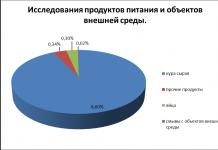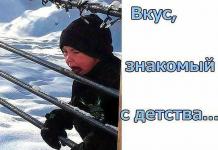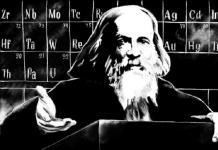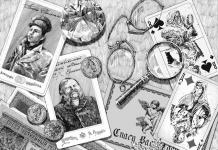Chemistry is a fascinating but challenging subject. And if the school still did not have the equipment for conducting experiments, then we can say that she completely passed by. But there is something in which every person should be guided at least minimally. This is the periodic table.
For schoolchildren, learning it is a real torture. If they see her in dreams, then only nightmares. There are so many elements, each has its own number ... But one mother of many children came up with an entertaining way, how to learn periodic table... It is suitable for both children and adults, and the reaction will gladly tell you about it. "So simple!".

Periodic table of chemical elements
As the experience of Karin Tripp, a mother of four children, shows, with the right approach, it is possible to learn everything. To attach to studying chemistry even small children, she decided to turn the periodic table of elements into a naval battlefield.

The game contains four pages with the periodic table - two for each player. Each player needs to draw his ships on one table, and on the other - to indicate his shots and the destroyed ships of the opponent with dots.

The rules of naval combat are the same as in the classic game. Only in order to shoot down the opponent's boat, you need to name not a letter with a number, but the corresponding chemical element.

This technique will allow children not only to learn the names of chemical elements. It promotes the development of memory and logical thinking. After all, children will analyze serial numbers and colors.

To make it easier for children to find the desired element at first, the rows and columns should be numbered. But, according to Karin, after a few days of playing "chemical sea battle" her children began to perfectly navigate the periodic table. They even knew the atomic masses and the ordinal numbers of the elements.

Over time, the rules of the game can get more complicated. For example, place a ship only within one family of chemical elements.

Even the eight-year-old daughter of an inventive mother who has not yet studied chemistry in school plays this game with pleasure. And for adults, this is a great way to have fun.

All pages of the periodic table for playing sea battle can be printed on a regular or color printer and used an unlimited number of times.

Custom homework on chemistry. We compose the periodic table from the drawn cards.
Homework topic: draw a card of a separate chemical element present in living organisms (biogen) with an illustration of its effect on living organisms.
Class - 8- Grade 10; complexity- high, intersubject; time execution - 30-40 minutes.
Job type - individual, and then in a group; check method- collection of illustrations of individual chemical elements in A4 format, and the compilation of a general periodic table from them.
Tutorials:
1) textbook of chemistry grade 10 - O.S. Gabrielyan, I. G. Ostroumov, S.Yu. Ponomarev, advanced level (CHAPTER 7. Biologically active compounds, p. 300).
2) textbook of chemistry grade 8 - O.S. Gabrielyan, (§ 5. Periodic table of chemical elements of D. I. Mendeleev. Signs of chemical elements, p. 29).
3) textbook of ecology 10 (11) grade - E. A. Kriksunov, V. V. Pasechnik, (Chapter 6. Environment and human health, 6.1. Chemical pollution of the environment and human health, p. 217).
4) textbook of biology 10-11 grade - General biology. A basic level of. Ed. Belyaeva D.K., Dymshitsa G.M. (Chapter 1. The chemical composition of the cell. § 1. Inorganic compounds, § 2. Biopolymers.).
Goals: the development of knowledge about biochemical processes in a living cell, geochemical processes in nature, obtained by schoolchildren independently and meaningfully, fixed by a drawing, creative drawing. Creation of unique visual aids for other students. Compilation of the author's unique "Periodic Table".
Explanatory note.
Homework essence in that the students draw the participation of each chemical element in geochemical processes. And then all the drawings are combined into a summary "Periodic Table", which can be hung on the wall in the classroom. A certain visual product of joint creativity is formed: "Ecology in Pictures". In different classes, different "Periodic Tables" are obtained, the main thing is to preserve the tabular form and make sure that all the drawings are on an A4 sheet. And also, so that a chemical sign of the element about which the plot is drawn is affixed in the corner of the sheet. First, each student chooses a specific chemical element to study. Then, independently, or with the help of a teacher, he searches for information, chooses the necessary one, comes up with a plot of the drawing, draws and places his drawing on the wall in a cell of the periodic periodic table for the corresponding chemical element. You can simplify / complicate the task by choosing from all the chemical elements only the most common on earth, or, conversely, the least common. You can select only biogens (chemical elements that make up living organisms) and draw educational cards with stories about them. You can choose macronutrients of living cells, or you can only micronutrients, etc. In environmental reference books now you can find a lot of different information on this topic.
Reference material: Biogenic are chemical elements that are constantly present in living organisms and play any biological role: O, C, H, Ca, N, K, P, Mg, S, Cl, Na, Fe, I, Cu.
Virtual "periodic table". Instead of a paper table on the wall in the classroom, you can organize a virtual table and the general work of students in it. For this, the teacher prepares a layout of the table in Google -documents and opens access to students. Students can draw with the help of computer programs, or they can download drawings made with pencils and paints. Here is the initial layout of such a table, partially filled in by the students.
Separate learning cards , with student sketches on the effect of specific chemical elements on living organisms (A4 format of each card).












APPENDIX. Table of chemical elements-nutrients, as a reference material for drawing plots of educational cards.
| Threshold concentrations of chemical elements in soils (mg / kg) and possible reactions of organisms (according to Kowalski) |
|||
| Chemical element | Disadvantage - lower threshold concentration | Norm | Excess - upper threshold concentration |
| Cobalt | Less than 2-7. Anemia, hypo- and avitominosis B, endemic goiter. | 7-30 | More than 30. Inhibition of vitamin B synthesis. |
| Copper | Less than 6-13. Anemia, diseases of the skeletal system. Non-ripening of cereals, dry top of fruit trees. | 13-60 | More than 60. Liver damage, anemia, jaundice. |
| Manganese | Up to 400. Bone disease, increase in goiter. | 400-3000 | More than 3000. Diseases of the skeletal system. |
| Zinc | Up to 30. Dwarf growth of plants and animals. | 30-70 | More than 70. Inhibition of oxidative processes, anemia |
| Molybdenum | Up to 1.5. Plant diseases. | 1,5-4 | More than 4. Gout in humans, molybdenum toxicosis in animals. |
| Boron | Less than 3-6. Dying off of points of growth of stems and roots of plants. | 6-30 | More than 30. Boron diarrhea (enteritis) in animals. |
| Strontium | More than 600. Urovsky disease, rickets, fragility of bones. |
||
| Iodine | Less than 2-5. Endemic goiter in humans | 5-40 | More than 40. Weakening of the synthesis of iodine compounds of the thyroid gland. |
On March 1, 1869, Mendeleev completed his work "Experience of a system of elements based on their atomic weight and chemical similarity." This day is considered the day of the discovery of the periodic law of the elements of D.M. Mendeleev. "The discovery of D. I. Mendeleev refers to the fundamental laws of the universe, such as Newton's law of gravitation or Einstein's theory of relativity, and D. M. Mendeleev is on a par with the names of these great physicists." Academician A.I. Rusanov.
"The periodic table has been and remains the main guiding star in the most recent solutions to the problem of matter." Prof. A. N. Reformatsky.
"When you approach the assessment of personalities like D. I. Mendeleev, to the analysis of their scientific work, one involuntarily wants to find in this work the elements most marked by the stamp of genius. Of all the signs that distinguish genius and its manifestation, two seem to be the most revealing: firstly, the ability to cover and combine broad areas of knowledge and, secondly, the ability to abrupt leaps in thought, to unexpected convergence of facts and concepts that for an ordinary mortal seem to be far apart and unrelated, at least until the moment when such a connection is discovered and proven. " L. A. Chugaev, professor of chemistry.
And Mendeleev himself understood the enormous significance of the law he discovered for science. And I believed in its further development. "Apparently, the future does not threaten the periodic law with destruction, but only promises superstructures and development." DI. Mendeleev.
The original view of the table, written by D.I. Mendeleev.
If all the scientific knowledge of the world were lost due to some kind of cataclysm, then for the revival of civilization one of the main laws would be the periodic law of D.I. Mendeleev. The advances in atomic physics, including nuclear energy and the synthesis of artificial elements, became possible only thanks to the Periodic Law. In turn, they expanded and deepened the essence of Mendeleev's law.
The periodic law played a huge role in the development of chemistry and other natural sciences. The mutual connection was discovered between all elements, their physical and chemical properties. This put before natural science a scientific and philosophical problem of great importance: this mutual connection must be explained.
The discovery of the periodic law was preceded by 15 years of hard work. By the time the periodic law was discovered, 63 chemical elements were known, there were about 50 different classifications. Most scientists compared only elements with similar properties to each other, so they could not discover the law. Mendeleev, on the other hand, compared everything, including dissimilar elements. Mendeleev wrote on the cards all the known information about the chemical elements and their compounds discovered and studied at that time, arranged them in the order of increasing their relative atomic masses and comprehensively analyzed this entire set, trying to find certain patterns in it. As a result of intense creative work, he discovered in this chain segments in which the properties of chemical elements and the substances formed by them changed in a similar way - periodically - periods. With the development of the theory of the structure of the electron shell of atoms, it became clear why the properties of atoms show periodicity with increasing atomic mass. Atoms with the same outer sphere make up one group. Atoms with the same number of outer spheres are one row. Atoms with nuclei that have the same charges, but different masses, have the same chemical properties, but different atomic weights, and are isotopes of the same chemical element. Essentially, the properties of atoms reflect the properties of the outer electron shells, which are closely related to the laws of quantum physics.
The periodic table itself has been transformed many times, displaying different information about the properties of atoms. There are also curious tables. 
The so-called short-period or short form of TM 

Long-period or long form of TM 
Extra long. 
State flags indicating the country where the item was first discovered. 
The names of elements that were canceled or turned out to be erroneous, such as the story of Didymus Di, turned out to be a mixture of two newly discovered elements, praseodymium and neodymium. 
Here, blue indicates the elements formed during the Big Bang, blue - synthesized during the primary nucleosynthesis, yellow and green colors indicate the elements synthesized, respectively, in the bowels of "small" and "large" stars. Pink - substances (nuclei) synthesized during supernova explosions. By the way, gold (Au) is still synthesized during collisions of neutron stars. Purple - artificially created in laboratories. But that's not the whole story ... 
Here, different colors indicate organic, inorganic and irreplaceable elements necessary for building the bodies of living beings, including us. 








Table-tower
Proposed in 2006 by Vitaly Zimmerman based on the ideas of Charles Janet. He studied the orbital filling of atoms - how the electrons are positioned relative to the nucleus. And on the basis of this, he divided all the elements into four groups, sorting them according to the configurations of the position of the electrons. The table is extremely simple and functional. 



The table is a spiral.
In 1964, Theodore Benfey proposed to place hydrogen (H) in the center of the table, and place the other elements around it in a spiral that spins clockwise. Already at the second turn, the helix stretches into loops, which correspond to transition metals and lanthanides with actinides; a place is provided for so far unknown superactinides. This gives the table the look of an extravagant design solution. 
The table is a rainbow spiral.
Invented in 1975 by chemist James Hyde. He was fond of organosilicon compounds, so it was flint that got into the base of the table, since it has a large number of bonds with other elements. Various categories of elements are also grouped into sectors and marked with the desired color. The table is more beautiful than analogs, but because of the curved shape it is not easy to use it. 






These tables show the sequence of filling the electronic casings. Some of them, anyway. All these tables look very exotic.
Isotope table. It displays the "lifetime" of various isotopes, their stability depending on the mass of the nucleus. However, this is no longer the periodic table, this is a completely different (nuclear physics) story ... 
In fact, German physicist Johann Wolfgang Dobereiner noticed the peculiarities of the grouping of elements as early as 1817. In those days, chemists did not yet fully understand the nature of atoms as described by John Dalton in 1808. In his "New System of Chemical Philosophy," Dalton explained chemical reactions by assuming that every elementary substance is composed of a specific type of atom.
Dalton theorized that chemical reactions produced new substances when atoms separate or join. He believed that any element consists exclusively of one type of atom, which differs from others in weight. Oxygen atoms weighed eight times more than hydrogen atoms. Dalton believed that carbon atoms are six times heavier than hydrogen. When elements combine to create new substances, the amount of reactants can be calculated based on these atomic weights.
Dalton was wrong about some masses - oxygen is actually 16 times heavier than hydrogen, and carbon is 12 times heavier than hydrogen. But his theory made the idea of atoms useful, inspiring a revolution in chemistry. Accurate measurement of atomic mass became a major challenge for chemists for decades to come.
Reflecting on these scales, Dobereiner noted that certain sets of three elements (he called them triads) show an interesting connection. Bromine, for example, had an atomic mass somewhere between that of chlorine and iodine, and these three elements all exhibited similar chemical behavior. Lithium, sodium and potassium were also a triad.
Other chemists noticed connections between atomic masses and, but it wasn't until the 1860s that atomic masses became well understood and measured enough to develop a deeper understanding. The English chemist John Newlands observed that the arrangement of known elements in order of increasing atomic mass resulted in a repetition of the chemical properties of every eighth element. He called this model "the law of octaves" in an 1865 article. But Newlands' model did not hold up very well beyond the first two octaves, prompting critics to suggest that he arrange the elements in alphabetical order. And as Mendeleev soon realized, the relationship between the properties of elements and atomic masses was a little more complex.
Organization of chemical elements
Mendeleev was born in Tobolsk, Siberia, in 1834 and was the seventeenth child of his parents. He lived a vibrant life, pursuing various interests and traveling along the road to outstanding people. While receiving higher education at the Pedagogical Institute in St. Petersburg, he almost died of a serious illness. After graduation, he taught in secondary schools (this was necessary to receive a salary at the institute), along the way studying mathematics and natural sciences for a master's degree.
He then worked as a teacher and lecturer (and wrote research papers) until he received a scholarship for an extended research tour in the best chemical laboratories in Europe.
Back in St. Petersburg, he found himself out of work, so he wrote an excellent manual in hopes of winning a big cash prize. In 1862, this earned him the Demidov Prize. He also worked as an editor, translator and consultant in various chemical fields. In 1865 he returned to research, received his Ph.D. and became a professor at St. Petersburg University.
Shortly thereafter, Mendeleev began teaching inorganic chemistry. Preparing to master this new (for him) field, he was not satisfied with the available textbooks. So I decided to write my own. The organization of the text required the organization of the elements, so the question of their best arrangement was constantly on his mind.
By early 1869, Mendeleev had made enough progress to realize that some groups of similar elements exhibited a regular increase in atomic masses; other elements with approximately the same atomic masses had similar properties. It turned out that ordering the elements by their atomic weight was the key to their classification.

D. Meneleev's periodic table.
According to Mendeleev's own words, he structured his thinking by writing down each of the 63 then known elements on a separate card. Then, through a kind of chemical solitaire game, he found the pattern he was looking for. By arranging the cards in vertical columns with atomic masses from low to high, he placed elements with similar properties in each horizontal row. Mendeleev's periodic table was born. He sketched a draft on March 1, sent it to print, and included it in his textbook, which was soon to be published. He also quickly prepared a work for submission to the Russian Chemical Society.
"Elements, ordered by the size of their atomic masses, show clear periodic properties," Mendeleev wrote in his work. "All the comparisons I have made have led me to conclude that the size of the atomic mass determines the nature of the elements."
Meanwhile, German chemist Lothar Meyer was also working on organizing the elements. He prepared a table similar to Mendeleev's, perhaps even earlier than Mendeleev. But Mendeleev published his first.
However, much more important than the victory over Meyer was how Mendeleev used his table to make about the undiscovered elements. In preparing his table, Mendeleev noticed that some of the cards were missing. He had to leave empty spaces so that the known elements could align correctly. During his lifetime, three empty spaces were filled with previously unknown elements: gallium, scandium and germanium.
Mendeleev not only predicted the existence of these elements, but also correctly described their properties in detail. Gallium, for example, discovered in 1875, had an atomic mass of 69.9 and a density six times that of water. Mendeleev predicted this element (he named it ekaaluminium), only for this density and atomic mass 68. His predictions for ekasilicon closely matched germanium (discovered in 1886) in atomic mass (72 predicted, 72.3 in fact) and density. He also correctly predicted the density of germanium compounds with oxygen and chlorine.
The periodic table has become prophetic. It seemed that at the end of this game this solitaire of the elements would reveal. At the same time, Mendeleev himself was a master in using his own table.
Mendeleev's successful predictions earned him legendary status as a master of chemical magic. But today historians argue about whether the discovery of the predicted elements cemented the enactment of his periodic law. The adoption of the law could be more related to its ability to explain established chemical bonds. In any case, Mendeleev's predictive accuracy has certainly drawn attention to the merits of his table.
By the 1890s, chemists widely recognized his law as a milestone in chemical knowledge. In 1900, the future Nobel laureate in chemistry William Ramsay called this "the greatest generalization ever made in chemistry." And Mendeleev did it without understanding how.
Math map
In many cases in the history of science, great predictions based on new equations have turned out to be correct. Somehow, mathematics is revealing some natural secrets before experimenters discover them. One example is antimatter, another is the expansion of the universe. In Mendeleev's case, predictions of new elements came about without any creative mathematics. But in fact, Mendeleev discovered a deep mathematical map of nature, since his table reflected the meaning of the mathematical rules governing atomic architecture.
In his book, Mendeleev noted that "the internal differences in the matter that atoms make up" may be responsible for the periodically repeating properties of elements. But he did not adhere to this line of thinking. In fact, over the years, he has pondered how important atomic theory is to his table.
But others could read the internal message of the table. In 1888, the German chemist Johannes Wieslitzen announced that the periodicity of the properties of the elements, ordered by mass, indicated that atoms were composed of regular groups of smaller particles. Thus, in a sense, the periodic table did indeed foresee (and provide evidence for) the complex internal structure of atoms, while no one had the slightest idea of what the atom actually looked like or whether it had any internal structure at all.
By the time of Mendeleev's death in 1907, scientists knew that atoms are divided into parts:, plus some positively charged component that makes atoms electrically neutral. The key to how these pieces line up came from the 1911 discovery when physicist Ernest Rutherford at the University of Manchester in England discovered the atomic nucleus. Shortly thereafter, Henry Moseley, who worked with Rutherford, demonstrated that the amount of positive charge in a nucleus (the number of protons it contains, or its "atomic number") determines the correct order of the elements in the periodic table.

Henry Moseley.
Atomic mass was closely related to Moseley's atomic number — closely enough that the ordering of elements by mass in only a few places differed from the ordering by number. Mendeleev insisted that these masses were wrong and needed to be re-measured, and in some cases he was right. A few discrepancies remained, but Moseley's atomic number fit perfectly into the table.
Around the same time, the Danish physicist Niels Bohr realized that quantum theory determines the arrangement of the electrons surrounding the nucleus, and that the farthest electrons determine the chemical properties of an element.
Such arrangements of external electrons will be periodically repeated, explaining the patterns that were originally revealed by the periodic table. Bohr created his own version of the table in 1922, based on experimental measurements of electron energies (along with some clues from the periodic law).
Bohr's table added elements discovered since 1869, but this was the same periodic order discovered by Mendeleev. Without the slightest idea about, Mendeleev created a table that reflects the atomic architecture, which was dictated by quantum physics.
The new Bohr table was neither the first nor the last version of Mendeleev's original design. Hundreds of versions of the periodic table have since been developed and published. The modern form - in a horizontal design as opposed to Mendeleev's original vertical version - became widespread only after World War II, thanks in large part to the work of the American chemist Glenn Seaborg.
Seaborg and his colleagues created several new elements synthetically, with atomic numbers after uranium, the last natural element on the table. Seaborg saw that these elements, transuranic (plus three elements that preceded uranium), required a new row in the table, which Mendeleev did not foresee. Seaborg's table added a row for those elements under a similar series of rare earths that also had no room in the table.
Seaborg's contribution to chemistry earned him the honor of naming his own element, the number 106 seborgium. It is one of several elements named after famous scientists. And on this list, of course, is element 101, discovered by Seaborg and his colleagues in 1955 and named Mendelevium - after the chemist who earned a place on the periodic table above all others.
Check out our news channel if you want more stories like this.
PERIODIC CHEMICAL CHART
The periodic table is a graphic representation of the periodic law. It contains 7 periods and 8 groups.
The short form of the table D.I. Mendeleev.
Semi-long version of D.I. Mendeleev.
There is also a long version of the table, it looks like a semi-long one, but only lanthanides and actinides are not taken out of the table.
The original table by D.I.Mendeleev
1. Period - chemical elements arranged in a line (1 - 7)
Small (1, 2, 3) - consist of one row of elements
Large (4, 5, 6, 7) - consist of two rows - even and odd
Periods can consist of 2 (first), 8 (second and third), 18 (fourth and fifth), or 32 (sixth) elements. The last, seventh period is incomplete.
All periods (except the first) begin with an alkali metal and end with a noble gas.
In all periods, with an increase in the relative atomic masses of elements, an increase in non-metallic and a weakening of metallic properties is observed. In long periods, the transition of properties from an active metal to a noble gas occurs more slowly (after 18 and 32 elements) than in small periods (after 8 elements). In addition, in small periods from left to right, the valence in compounds with oxygen increases from 1 to 7 (for example, from Na to Cl ). In large periods, at first the valence increases from 1 to 8 (for example, in the fifth period from rubidium to ruthenium), then a sharp jump occurs, and the valence decreases to 1 for silver, then increases again.
2. Groups - vertical columns of elements with the same number of valence electrons equal to the group number. Distinguish between main (A) and secondary subgroups (B).
Main subgroups consist of elements of small and large periods.
Side subgroups consist of elements of only large periods.
In the main subgroups, from top to bottom, metallic properties are enhanced and non-metallic properties are weakened. Elements of the main and secondary groups differ greatly in their properties.
The group number shows the highest valency of the element (except for N, O, F).
Common to the elements of the main and secondary subgroups are the formulas of higher oxides (and their hydrates). Higher oxides and their hydrates of elements I - III groups (except for boron), basic properties prevail, with IV to VIII - acidic.
|
Group |
III |
Vii |
VIII (except for inert gases) |
|||||
|
Higher oxide |
E 2 O |
EO |
E 2 O 3 |
EO 2 |
E 2 O 5 |
EO 3 |
E 2 O 7 |
EO 4 |
|
Higher oxide hydrate |
EON |
E (OH) 2 |
E (OH) 3 |
H 2 EO 3 |
H 3 EO 4 |
H 2 EO 4 |
NEO 4 |
H 4 EO 4 |
For the elements of the main subgroups, the formulas of hydrogen compounds are common. Elements of the main subgroups I - III groups form solids - hydrides (hydrogen in the oxidation state - 1), and IV - VII groups - gaseous. Hydrogen compounds of elements of the main subgroups IV groups (EN 4) - neutral, V groups (EN 3) - bases, VI and VII groups (H 2 E and NE) - acids.



































